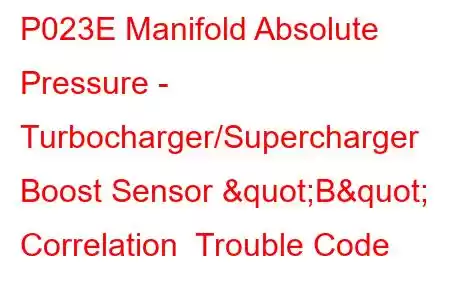P023E MAP - Turbo/SC Boost Sensor B Correlation
OBD-II Trouble Code Technical Description
Manifold Absolute Pressure - Turbocharger/Supercharger Boost Sensor B Correlation
What does that mean?
This is a generic powertrain diagnostic trouble code (DTC) that typically applies to OBD-II vehicles. That may include but is not limited to vehicles from Land Rover (Range Rover, Discovery), Ford, Chevrolet, Mazda, Dodge, Peugeot, Saab, Toyota, etc.
Although generic, the exact repair steps may vary depending on year, make, model and powertrain configuration.
If your OBD-II equipped vehicle has stored a code P023E, it means that the powertrain control module (PCM) has detected a discrepancy in the correlating signals between the manifold absolute pressure (MAP) sensor and the turbocharger/supercharger boost sensor which has been designated "B".
The "B" denotes a specific boost sensor in a system which may use multiple boost sensors in different locations. Consult a reliable vehicle information source to determine precisely which sensor the B references (for the vehicle in question). This code is applicable only to vehicles that are equipped with forced air induction devices Forced air induction devices include turbochargers and superchargers.
The MAP sensor provides the PCM with a voltage signal that reflects air density or pressure in the intake manifold. The voltage signal is received (by the PCM) as either kilopascal (kPa) units or inches of mercury (Hg). In Some vehicle applications, MAP is substituted for barometric pressure and measured in similar increments.
The turbocharger/supercharger boost pressure sensor (designated B) will likely be of a similar design to the MAP sensor. It monitors air density (boost pressure) inside the turbocharger/supercharger intake pipe and provides the PCM with an appropriate voltage signal.
A code P023E will be stored, and a malfunction indicator lamp (MIL) may be illuminated, if the PCM detects voltage signals between the MAP sensor and the turbocharger/supercharger boost sensor B which differ by more than a programmed degree. Multiple ignition cycles (with a failure) may be required for MIL illumination.
What is the severity of this DTC?
Overall engine performance and fuel efficiency may be adversely affected by the conditions which contribute to a code P023E. It should be categorized as severe.
What are some of the symptoms of the code?
Symptoms of a P023E trouble code may include:
Decreased engine performance Excessive rich or lean exhaust Delayed engine start-up (especially when cold) Diminished fuel efficiencyWhat are some of the common causes of the code?
Causes for this P023E trouble code may include:
Defective MAP/ turbocharger/supercharger boost sensor B Open or shorted MAP/ turbocharger/supercharger boost sensor B wiring or connector Engine failure (insufficient vacuum production) Restricted intercooler PCM or PCM programming errorWhat are some P023E troubleshooting steps?
I would first gain access to diagnostic scanner, a digital volt/ohmmeter (DVOM), a manual vacuum pressure gauge, and a reliable vehicle information source before attempting to diagnose a code P023E. Diagnosing any MAP sensor related code should include making sure that the engine is making sufficient vacuum. This may be done using the vacuum pressure gauge.
A visual inspection of all MAP/ turbocharger/supercharger boost sensor system wiring and connectors is in order if there are no intercooler obstructions and the air filter is relatively clean. Make repairs as required. Next, I would connect the scanner to the vehicle diagnostic port and retrieve all stored codes and freeze frame data. Freeze frame data could be best described as a snap shot of the exact circumstances which were occurring at the time of the malfunction which led t
Read: 45


